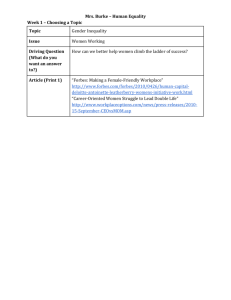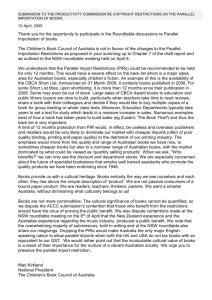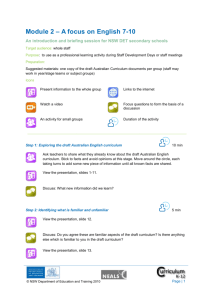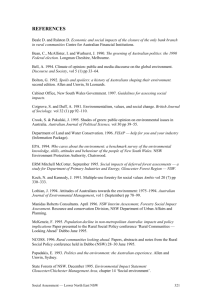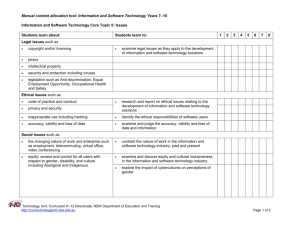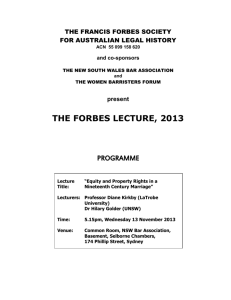FFS ANNUAL REPORT 2013 revised – 20 Jan 2014
advertisement
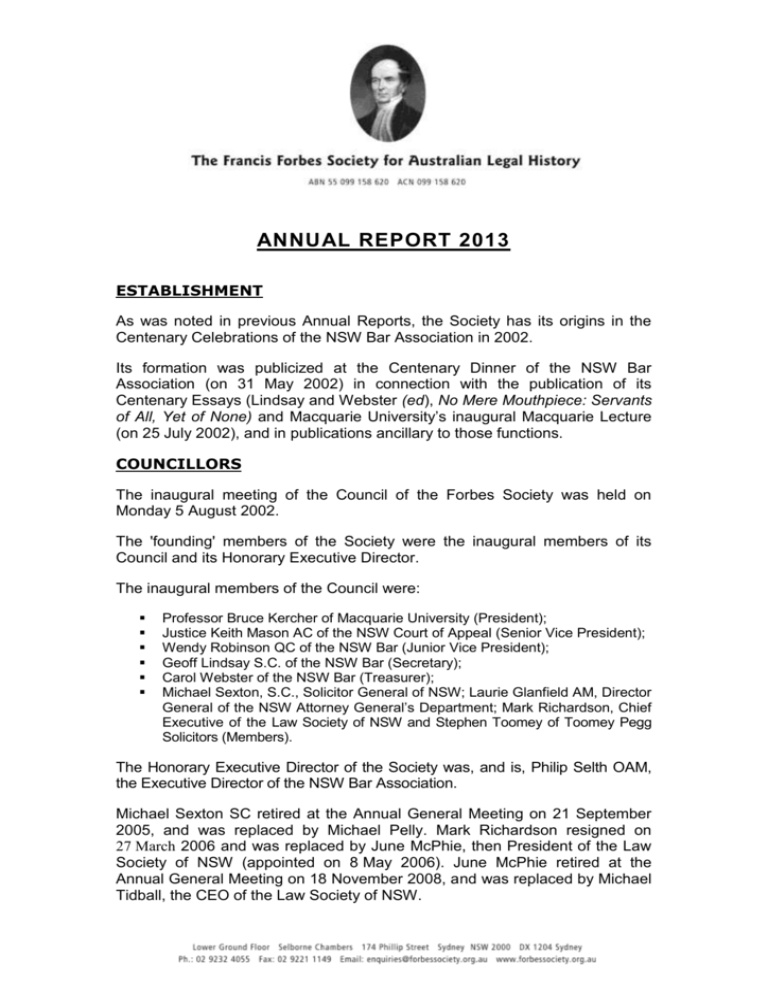
ANNUAL REPORT 2013 ESTABLISHMENT As was noted in previous Annual Reports, the Society has its origins in the Centenary Celebrations of the NSW Bar Association in 2002. Its formation was publicized at the Centenary Dinner of the NSW Bar Association (on 31 May 2002) in connection with the publication of its Centenary Essays (Lindsay and Webster (ed), No Mere Mouthpiece: Servants of All, Yet of None) and Macquarie University’s inaugural Macquarie Lecture (on 25 July 2002), and in publications ancillary to those functions. COUNCILLORS The inaugural meeting of the Council of the Forbes Society was held on Monday 5 August 2002. The 'founding' members of the Society were the inaugural members of its Council and its Honorary Executive Director. The inaugural members of the Council were: Professor Bruce Kercher of Macquarie University (President); Justice Keith Mason AC of the NSW Court of Appeal (Senior Vice President); Wendy Robinson QC of the NSW Bar (Junior Vice President); Geoff Lindsay S.C. of the NSW Bar (Secretary); Carol Webster of the NSW Bar (Treasurer); Michael Sexton, S.C., Solicitor General of NSW; Laurie Glanfield AM, Director General of the NSW Attorney General’s Department; Mark Richardson, Chief Executive of the Law Society of NSW and Stephen Toomey of Toomey Pegg Solicitors (Members). The Honorary Executive Director of the Society was, and is, Philip Selth OAM, the Executive Director of the NSW Bar Association. Michael Sexton SC retired at the Annual General Meeting on 21 September 2005, and was replaced by Michael Pelly. Mark Richardson resigned on 27 March 2006 and was replaced by June McPhie, then President of the Law Society of NSW (appointed on 8 May 2006). June McPhie retired at the Annual General Meeting on 18 November 2008, and was replaced by Michael Tidball, the CEO of the Law Society of NSW. Laurie Glanfield AM, formerly Director General of the NSW Attorney General’s Department resigned from the Council on 1 August 2013. In accordance with the Society’s constitution all Councillors retire at this Annual General Meeting and are eligible for re-election. CONSTITUTION The Forbes Society was registered as a public company, limited by guarantee, on 2 January 2002, and is authorised under section 150 Corporations Act 2001 (Cth), to dispense with the word “Limited” from its title. The registered office of the Society is care of the Office of the NSW Bar Association, Basement Level, Selborne Chambers, 174 Phillip Street, Sydney. “The Francis Forbes Fund” was established by Deed of Trust executed on 12 February 2002. Under the Deed the Society is trustee of the Fund. The Society and the Fund are endorsed as “income tax exempt charities”, and the Fund is endorsed as a “deductible gift recipient”, under the Income Tax Assessment Act 1997 (Cth). The NSW Department of Sport and Recreation has issued an “Authority to Fundraise” to the Society under the Charitable Fund Raising Act 1991 (NSW). ANNUAL FORBES LECTURE Since its foundation the Forbes Society has encouraged the study of the history of Australian law through an annual public lecture. The Forbes Lecture has become an important date in the legal calendar. 2013 Forbes Lecture The 2013 Forbes Lecture was delivered on 13 November 2013, by Professor Diane Kirkby and Dr Golder, on “Equity and Property Rights in a Nineteenth Century Marriage”. It was delivered in the Common Room of the NSW Bar Association. The lecture was chaired by Jane Needham SC, Senior Vice President of the Association. 2012 Forbes Lecture On 31 October 2012 Tony Cunneen of St Pius X College, Chatswood, delivered the 2012 Forbes Lecture (entitled “A Man for All Seasons: The Life and Times of Chief Justice Sir William Portus Cullen”) in the Common Room of the NSW Bar Association. Cullen was Chief Justice of New South Wales between 1910-1925. He was the first Chief Justice of the Supreme Court of NSW who was born, and wholly educated, in Australia. A revised form of the lecture is to be published in the Australian Law Journal. The Society was honoured by the service of the current Chief Justice of New South Wales, Justice TF Bathurst, as Chairman for the Lecture. His Honour was welcomed to that task by Emeritus Professor Bruce Kercher. 2 The Lecture brought to life the tumultuous times during which Chief Justice Cullen presided over the Supreme Court and, as a leading member of Australian society, helped to steer New South Wales through the traumas of World War I and a period of social upheaval that, at times, bordered on revolution. 2011 Forbes Lecture On 16 November 2011 Dr Shaunnagh Dorsett of UTS delivered the 2011 Forbes Lecture (entitled “Adapting Law to Circumstances of the Colony: The First Supreme Court Rules of New South Wales and New Zealand”) in the Common Room of the NSW Bar Association. Associate Professor Dorsett was introduced by Emeritus Professor Bruce Kercher, with Bernard Coles QC (the President of the NSW Bar Association) serving as Master of Ceremonies. The paper on which the Lecture was published as “Procedural Innovation: The First Supreme Court Rules of New South Wales and New Zealand” (2011) 35 Aust Bar Rev 128. 2010 Forbes Lecture On 17 November 2010 Dr Lisa Ford of UNSW, delivered the 2010 Forbes Lecture (entitled “Thinking Big about Early NSW: Colonial Law in Global Perspective”) in the Banco Court, Supreme Court of NSW. The event was chaired by Justice Virginia Bell of the High Court of Australia. Dr Ford was introduced by Emeritus Professor Bruce Kercher, Dr Ford’s paper was published in (2011) 34 Aust Bar Rev 204. The Lecture provided an occasion to celebrate the success of Lisa’s Settler Sovereignty: Jurisdiction and Indigenous People in America and Australia, 1788-1836 (Harvard University Press, 2010). In 2008 it won the Thomas J Wilson Memorial Prize awarded by Harvard University Press for “outstanding content, style and mode of presentation” of a “first book” approved by that publisher for publication. In 2010 it won two further awards. First, it won the 2010 NSW Premier’s Prize for the best general history book. Subsequently it was awarded the 2010 Littleton-Griswold Prize for the best book in any subject on the history of American law and society, awarded by the American Historical Association. 2009 Forbes Lecture On 5 November 2009 Associate Professor Mark Lunney of UNE, delivered the 2009 Forbes Lecture (entitled “the History of the Law of Tort in Australia”) in the Common Room of the NSW Bar Association. He was introduced by the Hon Justice Michael J Slattery with the Hon John Hamilton QC as MC on the night. Professor Lunney’s paper was published in (2010) 33 Aust Bar Rev 77 as “Federation and Beyond: What the History of Australian Tort Law can tell us”. 3 2008 Forbes Lecture On 6 November 2008 Professor Rosalind Croucher, then a Commissioner of the Australian Law Reform Commission, delivered the 2008 Forbes Lecture (entitled “150 Years of Torrens – Too Much, Too Little, Too Soon”) in the Common Room of the NSW Bar Association. She was introduced by Anna Katzmann S.C., President of the Association. Her paper was published in (2009) 31 Aust Bar Review 245. 2007 Forbes Lecture On 8 November 2007 Andrew Tink, formerly Shadow Attorney General in the NSW Parliament, delivered the 2007 Forbes Lecture on “The Life and Times of William Charles Wentworth” in the Bar Common Room. He was introduced by Anna Katzmann S.C., then President of the Bar Association. His biography of Wentworth was published by Allen & Unwin in 2009. His Forbes Lecture was published in (2009) 32 Aust Bar Review 316. 2006 Forbes Lecture On 9 November 2006 Rosemary Annable presented the 2006 Forbes Lecture on the topic “A Setting for Justice: Building for the Supreme Court of New South Wales” in the Bar Common Room. It addressed the history of the architecture of the Supreme Court. A guided tour of the Old Supreme Court building conducted by the Court Architect Diane Jones preceded the lecture. In 2007 UNSW Press (in collaboration with the Attorney General’s Department of NSW) published the long awaited book upon which Rosemary’s Lecture was based. It bears the same title, A Setting for Justice. 2005 Forbes Lecture On the 3 November 2005 the Hon Justice B H McPherson CBE, a judge of the Queensland Court of Appeal, presented the 2005 Forbes Lecture on the topic “New quilts from old rags”, in the Bar Common Room. It addressed the reception of English law in Australia. In 2007, following his retirement from the Court of Appeal, Bruce published the major work which was in preparation at the time of his Lecture. It is entitled, The Reception of English Law Abroad. It was published by the Supreme Court of Queensland Library. 2004 Forbes Lecture On 14 October 2004 Professor Bruce Kercher of Macquarie University and Tim Castle of the NSW Bar presented the 2004 Forbes Lecture, on the topic of “Bringing the Supreme Court to Order, 1828-1844”, in the Bar Common Room. The lecture was chaired by the then Shadow Attorney General for NSW, Andrew Tink MP. It has been published by the Society. 2003 Forbes Lecture On 15 October 2003, the Hon P.E. Powell A.M. QC presented the 2003 Forbes Lecture (entitled “The Origins and Development of the Protective 4 Jurisdiction of the Supreme Court of NSW”) in the Banco Court. It has been published by the Society. 2002 Forbes Lecture On 28 November 2002 I. M. Barker QC presented the inaugural Forbes Lecture entitled “The History of Trial by Jury in NSW” in the Banco Court, with Chief Justice Spigelman as the guest of honour and Professor Kercher as the Master of Ceremonies. It was published by the Society. It is now accessible on the Society’s website. PUBLIC LECTURES FOR 2013 Justice Michael Pembroke delivered the 2013 J.H. Plunkett Lecture, in the Common Room of the NSW Bar Association, on 15 October 2013. The lecture was chaired by Greg Smith SC, Attorney-General for the State of NSW. Justice Pembroke, author of “Arthur Phillip: Sailor, Mercenary, Governor, Spy” (Hardie Grant Books, 2013) spoke of Phillip’s career, life and times. On 24 October 2013 David Ash, the Editor of the Forbes Flyer, delivered the Forbes Oration, in Forbes, as the guest of the Council of the City of Forbes. OTHER PUBLIC LECTURES, 2011-2012 On 24 March 2012 the Faculty of Law at the University of Technology, Sydney, the Forbes Society and the NSW Bar Association jointly conducted a Symposium on The Legal Profession and the Defence Forces: Historical Connections. The principal Event Co-ordinators were Associate Professor Shaunnagh Dorsett and Tony Cunneen. The symposium was held at UTS. On 25 July 2012 Professor Graham Greenleaf of UNSW and the Australasian Legal Information Institute (better known as AustLII) delivered a public lecture (entitled “Law Reporting, and Legal Research, in an Electronic Age (and the Australasian Legal History Project)”) in the Common Room of the NSW Bar Association. The event was chaired by the NSW Attorney-General, the Hon. Greg Smith SC, MP. On 9 August 2012 Professor Mark Lunney of the Law Faculty of the University of New England delivered a public lecture (entitled “Fleming’s ‘Law of Torts’: Australian-made or Foreign Import? Australia’s Role in Making the ‘King’ of Torts”) in the Common Room of the NSW Bar Association. The Society was honoured to have Justice James Allsop, President of the NSW Court of Appeal, serve as Chairman for the event. Professor Lunney was introduced by the Head of UNE’s Law School, Professor Michael Stuckey. On 11 September 2012 the Society was honoured by Attorney-General Greg Smith’s presentation of the Inaugural JH Plunkett Lecture (entitled “The Contribution of Irish-Australian Lawyers to the Australian Legal System”) in the Common Room of the New South Wales Bar Association. The Lecture 5 was chaired by Mr BA (Bernie) Coles QC, the President of the Bar Association. The paper on which the lecture was based was published in (2012) 36 Aust Bar Rev 110. TUTORIALS IN AUSTRALIAN LEGAL HISTORY Throughout 2013 members and friends of the Forbes Society (including judges, tipstaves and research officers of the Supreme Court of NSW) have met, in Court No 1 of the Hospital Road Court Complex in Sydney, for tutorials in Legal History styled “Understanding Australian Law through Legal History”. Each tutorial has been led by a presenter, with all present participating in discussion. To date, presentations have been made by Chief Justice T.F Bathurst; Justice Emmett of the NSW Court of Appeal; Justice Button, Justice Black, Justice Lindsay and Acting Justice Young of the Supreme Court of NSW; Nick Manousaridis, now a judge of the Federal Circuit Court of Australia; David Ash and James Watson of the NSW Bar; and Robert Turnbull, Ben Chen and Clare Langford of the staff of the Supreme Court of NSW. Before year’s end, further presentations will also be made by Acting Justice Peter Young and Larissa Reid of the Law Courts Library, Sydney. The tutorials have produced a volume of research materials which the Society hopes will, in due course, provide a foundation for the publication of a work, or works, on the doctrinal history of Australia Law. THE LEGAL HISTORY DISCUSSION GROUP From time to time the Society has convened for its members and friends a “Legal History Discussion Group” meeting in the premises of the NSW Bar Association. These meetings (held in the evening, commencing at 5.30pm and concluding no later than 7.00pm) have provided a forum in which people interested in legal history can learn of recent developments, present papers and exchange ideas. The Discussion Group has not met in 2013, but plans to meet in 2014. 6 THE SOCIETY’S WEBSITE The Society’s website (www.forbessociety.org.au) can be used as a means of publicising research projects, inviting comments on draft papers and publishing papers. Members and friends of the Society are invited to use it accordingly. THE CAPITAL PUNISHMENT DATABASE The Australian Capital Punishment Database Project, under the supervision of Tim Castle in collaboration with Dr Amanda Kaladelfos, is substantially complete. Consideration is being given to a formal launch. PUBLICATIONS The Society's first publication, in 2003, was the 2002 Francis Forbes Lecture, given by Ian Barker QC, Sorely Tried - Democracy and Trial by Jury in New South Wales, released in October 2003. It is now out-of-print, but published electronically on the Society’s website. The Society has published five further books: The 2003 Francis Forbes Lecture, given by Philip Powell AM QC, The Origins and Development of the Protective Jurisdiction of the Supreme Court of New South Wales. Dowling's Select Cases 1828 to 1844, edited by T D Castle and Bruce Kercher - the notebooks of Sir James Dowling, the second Chief Justice of NSW. The 2004 Francis Forbes Lecture, given by T D Castle and Bruce Kercher, The Dowling Legacy - Foundations of an Australian legal culture 1828 - 1844. Callaghan’s Diary, edited by J M Bennett AM, formally launched by Judge Greg Woods QC on 31 May 2006. The Kercher Reports: Decisions of the New South Wales Superior Courts, 1788 to 1827, edited by Bruce Kercher and Brent Salter. In 2011/2012 the Forbes Society assisted with publication of two books: (a) Professor John McLaren’s - Dewigged, Bothered and Bewildered: British Colonial Judges on Trial, 1800-1900 (copublished with the Osgoode Society for Canadian Legal History); and 7 (b) Dr Paula J Byrne’s - Judge Advocate Ellis Bent: Letter and Diaries, 1810-1821. AVAILABILITY OF FORBES SOCIETY PUBLICATIONS By an arrangement with The Federation Press, these publications can generally be obtained from that publisher. Website: Email: Telephone: Fax: www.federationpress.com.au info@federationpress.com.au (02) 9552 2200 (02) 9552 1681 Several Forbes Lectures and entries in the Society’s Australian Legal History Essay Competition have been published in the Australian Bar Review. THE FORBES FLYER The Society’s newsletter for members, the Forbes Flyer, is published quarterly via email and on the Society's web site. The Editor, David Ash, has developed what has become an entertaining, regular publication reaching out beyond the legal profession, to academia and the general public. Our thanks are due to David. THE AUSTRALIAN LEGAL HISTORY SCHOOL ESSAY COMPETITION The Inaugural Competition (2007-2008) In March 2007 the Society launched the inaugural Australian Legal History School Essay Competition. The Society awarded a prize to James Triggs, a Year 9 student at Doncaster College in Victoria. His essay (entitled “Authority, Democracy and the Rule of Law”) was subsequently published in the Australian Bar Review at (2008) 30 Aust Bar Rev 221) and on the Society’s website. The Second Annual Competition (2008-2009) The second annual Essay Competition was launched in February 2008. Its theme was: “The Importance to the Effective Working of the Legal System of Individual Honesty, a Well-Informed Conscience and Trust”. More specifically, the Essay Topic was: “Honesty, Legal Ethics and the Limits of a Guilty Secret”. The Essay Question was: “How can a lawyer defend somebody he or she ‘knows’ is ‘guilty’?...What is it to ‘know’ that somebody is ‘guilty’…Okay, to be more precise: What are, or should be, the ethical obligations of a lawyer acting for a client who, after being charged with a crime, makes a confidential confession of guilt’. Discuss this question from the perspective of a member of the 8 community (who is not a lawyer) using examples drawn from the Dean Controversy (1895-1896) and/or Tuckiar’s Case (1932-1934)”. Potential Entrants in the Competition were assisted by a publication on the Society’s website of Background Information Paper entitled, “A Question of Conscience, a Question of Trust”. The results of the Competition were formally announced on Australia Day, 2009. The Forbes Society awarded three prizes to essayists: two to Tertiary Students, and one to a Junior High School Student. The winners in the University or Tertiary Student Categories were Adam Arnold of the University of New South Wales and Sarah Dorn of the University of Melbourne. Adam’s essay was published in the Australian Bar Review ((2009) 31 Aust Bar Rev 352) and on the website of The Australian newspaper (www.theaustralian.com.au/legalaffairs). The winner in the Junior High School Category was Ben Nam of Year 8 at St Pius X College at Chatswood in NSW. The Third Annual Competition (2009-2010) The third annual Essay Competition was launched in December 2008. Its Theme was: “A foundational objective of law in a modern democratic state is to serve, and protect, “the people” (all the people, not just a few) as the ultimate source of legal authority and, for that purpose, to adapt (in an orderly and principled way) to the changing needs of society”. The Essay Topic was: “Land ownership, power and sovereignty (supreme authority in a system of government) as an example of law and society changing over time, and between places, with “new law” and “old” blending in ways imperceptible to a casual observer”. The Essay Question was: “Who owns this land, anyway? Discuss whether Australian history has any lessons for us, today, about the meaning or significance of “land ownership”. Do so by reference to one or more of: (a) Australia as a “settled” or “conquered” territory, and Aboriginal Land Rights; (b) the land titles system (known as the “Torrens System”) devised by Robert Richard Torrens; and/or (c) debate about whether Australia should, as a modern sovereign nation, be a republic”. Potential Entrants in the Competition were assisted by four publications on the Society’s website of Background Information Papers entitled, “Living with Property”, “Living in Community”, “Folklore Rules: The Origins and Growth of Australian Law”, “Snapshots in the Mirror: Paradigms for Australia Day” and “By your Deeds Be Known: Episodes in Australasian Legal History”. The results of the Competition were formally announced on Australia Day, 2010. The Society awarded two prizes to essayists: both Junior High School Students. The principal prize was awarded to Isabelle Urbano, a student at Camberwell Girls’ Grammar School in Victoria. Her essay, entitled “The Peoples Land” was published in the Australian Bar Review: (2010) 33 Aust Bar Rev 70. A Commendation was awarded to Andrew Long of St Pius X College in Chatswood, NSW. 9 The Fourth Annual Competition (2010-2011) The fourth annual Essay Competition was launched in December 2009. It was sponsored by the New South Wales Bar Association, the Law Society of New South Wales, the Law School at Macquarie University, Abbeys Bookshop, the Federation Press, State Records NSW and the State Library of New South Wales. It was also actively supported by the Legal Affairs Section of The Australian newspaper. The 2010 Competition Theme was: “An important function of the law in any society is to reconcile tensions between self interest and altruism and between personal responsibility and a need to be mindful of the welfare of the community”. The Essay Topic was: “How moral imperatives of altruism (regard for others as a principle of action) and autonomy (personal freedom and self government) play out in the law, using as illustrations: (a) the concept of an actionable ‘wrong’ (what lawyers call a ‘tort’) in the ‘law of negligence’ applied in civil proceedings between litigants asserting rights as individuals; (b) the criminal law, when the State seeks redress in court proceedings brought against an individual in the name of the public; and (c) the provision of a public apology for a ‘collective wrong’ by a parliament speaking in the name of the State and as a representative of its citizens”. The Essay Question was: “Can Australian history teach us anything about the role of altruism and personal responsibility in the law? Discuss this question by reference to one or more of the following: (a) The civil law of negligence: the idea (found in the law of negligence as applied by courts exercising civil jurisdiction) that one person might owe to another person a ‘duty of care’, a breach of which entitles the other person to an award of damages (compensation) in proceedings that he or she might institute against the negligent party, contrasting: (i) the famous formula of Lord Atkin in Donoghue v Stevenson [1932] AC 562 at 580 (‘the Snail in the Ginger Beer Bottle Case’), for determining whether a ‘duty of care’ is owed by one person to another in the law of negligence; and (ii) the determination of the High Court of Australia (in Cole v South Tweed Heads Rugby League Football Club Limited [2004] HCA 29; 217 CLR 469 at [9]-[18] and [129]-[132] and CAL No. 14 Pty Limited v Motor Accidents Insurance Board and Scott [2009] HCA 47 at [49] and [52]-[57]) that publicans owe no general duty of care to patrons in relation to the amount of alcohol served and the consequences of its service, save in exceptional circumstances; and/or (b) The Criminal Law of Homicide: the idea that, outside war, no person is entitled to save his or her own life by killing another, an issue debated in The Queen v Dudley and Stephens (1884) 14 QBD 273 (and 560) at 286-288, where a court held that ‘necessity is no defence to a charge of murder’ and, accordingly, shipwrecked sailors bound for Australia were not entitled to cannibalise their cabin boy to survive; and/or (c) Cases Involving ‘Collective Wrongs’: the plight of ‘the Stolen Generations’ and ‘the Forgotten Generations’ to whom Australia’s Parliament delivered formal apologies on 13 February 2008 and 16 November 2009 respectively”. Potential Entrants in the Competition were assisted by an introductory outline on each of these three nominated subject areas. 10 The Prize for the 2010 Competition was awarded to Sarah Webster, a Year 10 student at Cecil Hills High School in Sydney, whose work was supervised by Mr Ashok Shandil, a History Teacher at the School. Sarah’s essay, entitled “Illustrations” was published at (2011) 34 Aust Bar Rev 231. The Fifth Annual Competition (2011-2012) The fifth annual Essay Competition was launched in early 2011. Essayists were invited to address a theme, topic or question of their own choice on “Australian Legal History” or to address the following question: “Does Australian history offer examples of why the law does not recognise a contractual right to a reward unless a claimant has acted in reliance on the offer of a reward, but insists that anybody who makes an offer to the public must make good on the offer to anybody who does act in reliance upon it? Discuss this question by reference to one or more of R v Clarke (1927) 43 CLR 227; Australian Woollen Mills Pty Limited v The Commonwealth (1942) 92 CLR 424 at 456-560; or Carlill v Carbonic Smokeball Company [1893] 1 QB 256”. The Competition presented several departures from previous Competitions. The first was an invitation to potential entrants to formulate their own theme, topic or question. Prizes for the 2011 Competition were announced on Australia Day 2012. Major prizes were awarded to Christine Iacono of Macquarie University (in the Tertiary Students Category) and Ben Nam of Year 11 at James Ruse Agricultural High School (in the Senior Secondary School Students Category). Christine’s essay addressed the question whether, from a legal perspective, the “Rum Rebellion” against Governor Bligh on 26 January 1808 can be justified. It was published in (2012) 35 Aust Bar Rev 307. Ben’s essay addressed the Essay Competition’s set question about the law of contract as it relates to rewards offered to the public. Ben was a second-time winner of the Competition. In 2008, as a Year 8 student at St Pius X College, Chatswood, he won a prize in the Junior Secondary Student Category. Christine and Ben each received a formal certificate, cash and a book voucher from Abbeys Book Shop (www.abbeys.com.au) as a personal prize for their respective essays. Ben’s School also received a cash award and an Abbey’s book voucher. The Society awarded several Certificates of Merit to entrants in the Competition. In the Tertiary Students Category, Merit Certificates were awarded to Martin Bernhaut (Sydney University/College of Law), Rosa Grahame (Australian National University), Leah Mills (University of New England) and Alice Rumble (ANU). In the Senior Secondary School Students 11 Category, Merit Certificates were awarded to James Begeng, Michael Loomes and Ciaan Perera, all of Year 11 at St Pius College, Chatswood. The Sixth Annual Competition (2012-2013) The Sixth Annual Essay Competition was launched in January 2012. Essayists were been invited to address a theme, topic or question of their own choice on “Australian Legal History” or to address one of four set questions. The first set question related to the reception of English law in Australia. It is in the following terms: “According to English common law, settled colonies (such as those in Australia were declared to be) received the laws of England as their foundation stones. The common law formula was that English laws were received so far as they were ‘applicable to their own situation and condition of any infant colony’. (William Blackstone, Commentaries on the Laws of England, 9th ed, 1783 (reprinted 1978) vol 1, pp 108-109.) In 1828, the formula was placed into statutory words by the Australian Courts Act (9 Geo 4 c 83) s 24. It provided that all the laws of England shall be applied in the courts of NSW and Van Diemen’s Land (Tasmania) ‘so far as the same can be applied in the said colonies’. The common law and statutory expression thus both allowed some room for variations between colonial law and the laws of England. How far could those variations go legitimately? What do the cases on this topic say about the nature of the colony compared with its country of origin?” The second set question related to “Common Roots in British Colonial Legal History”. It is expressed in the following terms: “Is there any pattern to similarities in the legal histories of Australasia and Canada (or India)?” The third set question related to “‘Mining Rights’ in Australian Legal History”. It is in the following terms: “In the search for Australia’s national character are there any useful parallels, or contrasts to be made, between the rights and obligations of miners associated with the Eureka Stockade Rebellion of the 1850s and debates about the rights and obligations of miners in modern Australia?” The fourth set question related to “The Australian Parliament’s ‘Marriage Power’”. It is in the following terms: “Does legal history have anything to teach us about whether, on a proper construction of the Australian Constitution, the national Parliament’s ‘Marriage Power’ should be interpreted as including a 12 power to enact legislation defining a marriage as including a same sex relationship?” The results of the Competition were formally announced on Australia Day, 2013. Prizes were awarded to Alice Rumble of the Australian National University (in the Tertiary Students Category), Sarah Webster of Year 12 at Cecil Hills High School (in the Senior Secondary School Category) and Jenwai Huong of Year 10 at Hornsby Girls High School (in the Junior Secondary School Category). Alice’s essay (entitled “That’s Not Your Prerogative: An Examination of the Governor’s Power to Exclude in 1888”) examined whether a Governor in colonial NSW had a prerogative power to exclude aliens. Her supervisor was Professor Mark Lunney, now of the University of New England. The Seventh Annual Competition (2013-2014) The Seventh Annual Essay Competition was launched in January 2013. Essayists have been invited to address a theme, topic or question of their own choice on “Australian Legal History” or to address one of the following set questions: SET QUESTION No. 1 (Not compulsory); The Reception of English Law in Australia: Cable v Sinclair [1788] NSWKR 7; (1788) NSW Sel.Cas. (Kercher) 15 is now regarded as an historical cornerstone of the rule of law in Australia. In the first civil case determined in the Colony two convicted felons, transported to New South Wales on the First Fleet, successfully sued the captain of the ship upon which they were transported. They were awarded damages for loss of their baggage on the trip to Australia. In Dugan v Mirror Newspapers Limited ((1978) 142 CLR 583 at 587.2, 589.8, 590.5 and 603.9; [1978] HCA 54 per Barwick CJ at [9], Gibbs J at [3]-[4] and Jacobs J at [8]) the High Court of Australia determined that, under the common law inherited by the Colony of New South Wales from England, a capital felon lacked capacity to sue for a civil wrong. Can these two judgments stand together? Considering each judgment in turn, was it correctly decided having regard to the principle (embodied in the common law by reference to William Blackstone, Commentaries on the Laws of England, 9th ed, 1783 (reprinted 1978) volume 1, pp 101-109 and in Imperial legislation by the Australian Courts Act (9 Geo IV c 83), s 24) that English laws were to be received by a settled colony so far as those laws were applicable to the situation and condition of the infant colony? Does the reasoning in Cooper v Stuart (1889) 4 App Cas 286 at 291 (extracted in Dugan v Mirror Newspapers Limited at 142 CLR 590; [1978] HCA 54 per Barwick CJ at [4]) offer any basis upon which the two judgments can be reconciled? If Dugan v Mirror Newspapers Limited had arisen for decision after enactment of the Australia Acts 1986 (Cth/UK), when Australia became fully independent of the Imperial power of Britain, would it have been decided in the same way? 13 SET QUESTION No. 2 (Not compulsory); Outsiders in the law of Colonial Australia (women, convicts and indigenous Australians): Discuss, from the respective perspectives of (a) a free woman married to a capital felon in Colonial Australia and (b) an indigenous Australian, the proposition that Australian law has never countenanced slavery. SET QUESTION No. 3 (Not compulsory); Capital Punishment: Is the aversion of modern Australia to capital punishment in any way linked with the nation’s historical roots in a convict society in which the prospect, or actuality, of capital punishment was a known quantity? SET QUESTION No. 4 (Not compulsory); The historical role of the High Court of Australia: Discuss the historical significance of the High Court of Australia in the Australian legal system by reference to one or more of its seminal judgments, such as (for example only) the following judgments (reported in the Commonwealth Law Reports and both the website of the High Court and the website of the Australasian Legal Information Institute): (a) “The Engineers’ Case” (Amalgamated Society of Engineers v Adelaide Steamship Co Limited (1920) 28 CLR 129; [1920] HCA 54). (b) Tuckiar v R (1934) 52 CLR 335; [1934] HCA 49. (c) “The First Uniform Tax Case” (South Australia v Commonwealth (1942) 65 CLR 373; [1942] HCA 14, “the Second Uniform Tax Case” (Victoria v Commonwealth (1957) 99 CLR 575; [1957] HCA 54) and Pape v Federal Commissioner of Taxation (2009) 238 CLR 1; [2009] HCA 23 about the nature of, and limitations on, the taxation and spending powers of the Commonwealth Government in the Australian federal system. (d) “The Communist Party Case” (Australian Communist Party v Commonwealth) (1951) 83 CLR 1; [1951] HCA 5. (e) “The Tasmanian Dam Case” (Commonwealth v Tasmania) (1983) 158 CLR 1; [1983] HCA 21. (f) “The Mabo Case” (Mabo v Queensland (No 2)) (1992) 175 CLR 1; [1992] HCA 23. (g) Kable v Director of Public Prosecutions (NSW) (1996) 189 CLR 51; [1996] HCA 24. (h) “The Political Free Speech Case” (Lange v Australian Broadcasting Corporation) (1997) 189 CLR 520; [1997] HCA 25. (i) Roach v Electoral Commissioner (2007) 233 CLR 162; [2007] HCA 43. The Competition Guidelines include short “Background Notes” on each of the four set questions. 14 The results of the Competition will be formally announced on Australia Day, 2014. THE OSGOODE SOCIETY Membership of the Osgoode Society is open to all comers, as is membership of the Forbes Society. As is apparent from its website (www.osgoodesociety.ca), the publications and programme of the Osgoode Society are worthy of both emulation and engagement. THE SELDEN SOCIETY The Forbes Society continues to have a close, collaborative connection with the Selden Society. Like the Osgoode Society, it was an inspiration for establishment of the Forbes Society. Membership of the Selden Society too is encouraged. The Australian Secretary of the Selden Society is the Librarian of the Queensland Supreme Court Library. Contact details are as follows: Supreme Court Librarian Supreme Court of Queensland Library PO Box 15019 CITY EAST QLD 4002 AUSTRALIA +61 7 3247 4373 +61 7 3247 9233 libr...@sclqld.org.au ACKNOWLEDGEMENTS A special acknowledgment, and grateful thanks, is recorded for the long service of Laurie Glanfield AM as a foundation member of the Council of the Forbes Society. Laurie resigned from the Council when he moved from the Office of Director General of the NSW Attorney-General’s Department to another senior office within the Government of NSW. The Society acknowledges the assistance it has received through the voluntary efforts of many people. Particular thanks are due to members of the Council and to David Ash (as Editor of the Flyer), Chris Winslow (as Honorary Publicity Officer), Fiona Williams (Personal Assistant to Carol Webster SC) and Shari Williams (Associate to Justice Lindsay) and Ben Chen and Herbert Kamanga (Tipstaves to Justice Lindsay). The continuing support of Philip Selth OAM as Honorary Executive Director of the Society, and the support of the Bar Association generally, is vital. Particular thanks go to Chris D’Aeth and Anna Hurtig for their assistance in organising the Society’s programme of Lectures, and to Chris Winslow for his assistance in maintenance of the Society’s Website. Thanks are also due to Tony Cunneen for agreeing to take on the role of maintenance of the website. The Society also acknowledges the support it receives from sponsors of the annual Australian Legal History Essay Competition: Abbey’s Book Shop, The Federation Press, the NSW Bar Association, The Law Society of NSW, 15 Macquarie Law School, State Records NSW and The State Library of NSW. Special thanks are due to the Editor of the Legal Affairs Section of The Australian, Mr Chris Merritt, and his team of journalists, including Michael Pelly. Their support for the Competition significantly aids the Society’s efforts to bring both the Competition and the work of the Society to the notice of a national audience. Date: 25 November 2013 (JUSTICE) GEOFF LINDSAY CAROL WEBSTER S.C. Secretary Treasurer/Assistant Secretary 16

